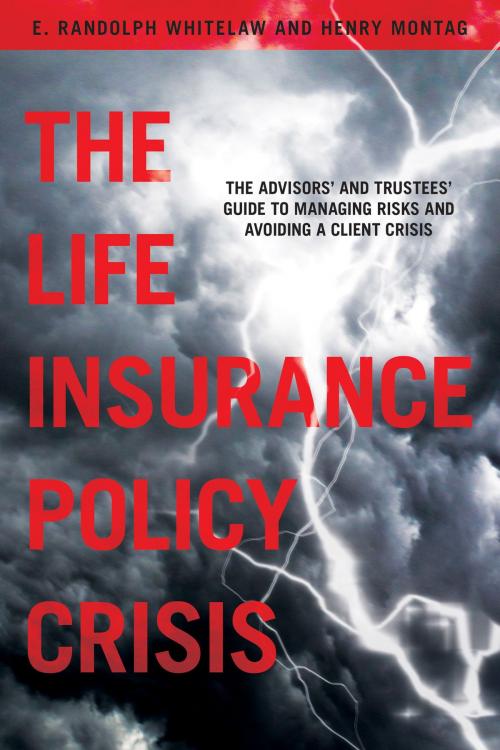The Life Insurance Policy Crisis
The Advisors and Trustees Guide to Managing Risks and Avoiding a Client Crisis
Nonfiction, Reference & Language, Law, Insurance, Estates & Trusts, Business & Finance, Industries & Professions| Author: | E. Randolph Whitelaw, Henry Montag | ISBN: | 9781634256186 |
| Publisher: | American Bar Association | Publication: | June 1, 2017 |
| Imprint: | American Bar Association | Language: | English |
| Author: | E. Randolph Whitelaw, Henry Montag |
| ISBN: | 9781634256186 |
| Publisher: | American Bar Association |
| Publication: | June 1, 2017 |
| Imprint: | American Bar Association |
| Language: | English |
For many years, life insurance was considered one of the most ethical and stable financial services businesses. But, following the introduction of flexible premium non-guaranteed death benefit products in the early 1980s, this reputation gradually changed. Today there is a life insurance policy crisis for reasons predicted 35 years ago, and it requires attention in order to avoid policy lapse without value along with allegations of deceptive and misleading practices.
How could this happen? Policy crediting rates have continually declined from the 15% non-guaranteed range to the guaranteed minimum, typically 4%. Sales agents had the software to prepare illustrations at crediting rates known not be sustainable over a 25 to 50-year time period, giving rise to the 'win the illustration contest' sales era. As the crediting rate drop to the guaranteed minimum, cost of insurance charges increased, which accelerates the probability of policy lapse especially with policies insuring seniors if corrective action is not taken. However, issuing life insurance carriers and most ‘sales’ agents do not offer post-sales policy risk management services, much less such services that meet a ‘dispute defensible’ standard. The warning signs commenced over 25 years ago but inattention has persisted. Today, many policy holders are faced with a major dilemma: either pay a significantly higher annual , or significantly reduce the death benefit, or surrender/sell the policy and lose the planning benefits they’ve paid into for decades, or do nothing an await lapse without value. This crisis has been covered by The New York Times and the Wall Street Journal, but unfortunately shows no signs of abating.
The Life Insurance Policy Crisis pulls back the veil on this looming crisis, and explains the solutions for fixing it. Authors E. Randolph Whitelaw and Henry Montag bring their 75 years of combined experience in financial planning and insurance counseling to review the readily-available post-sales policy administration and creditable risk management options that life insurance companies, sales agents and policy owners have ignored for decades. They explain the intervention process trusted advisors can recommend to policy owners to avoid unexpected lapse, obtain creditable fact-based risk management, and ensure a favorable planning outcome.
Topics include:
A history of the lapsing life insurance policy crisis and the questionable deceptive and misleading practices that led to it
A fresh look at the sustainability of existing policies
Restoring customer confidence in the life insurance policy distribution system
Reforms that can help all policies remain solvent
Best practices in litigating against the predatory practices of the life insurance industry
Sample documents and reference articles to resolve many of the identified problems
For many years, life insurance was considered one of the most ethical and stable financial services businesses. But, following the introduction of flexible premium non-guaranteed death benefit products in the early 1980s, this reputation gradually changed. Today there is a life insurance policy crisis for reasons predicted 35 years ago, and it requires attention in order to avoid policy lapse without value along with allegations of deceptive and misleading practices.
How could this happen? Policy crediting rates have continually declined from the 15% non-guaranteed range to the guaranteed minimum, typically 4%. Sales agents had the software to prepare illustrations at crediting rates known not be sustainable over a 25 to 50-year time period, giving rise to the 'win the illustration contest' sales era. As the crediting rate drop to the guaranteed minimum, cost of insurance charges increased, which accelerates the probability of policy lapse especially with policies insuring seniors if corrective action is not taken. However, issuing life insurance carriers and most ‘sales’ agents do not offer post-sales policy risk management services, much less such services that meet a ‘dispute defensible’ standard. The warning signs commenced over 25 years ago but inattention has persisted. Today, many policy holders are faced with a major dilemma: either pay a significantly higher annual , or significantly reduce the death benefit, or surrender/sell the policy and lose the planning benefits they’ve paid into for decades, or do nothing an await lapse without value. This crisis has been covered by The New York Times and the Wall Street Journal, but unfortunately shows no signs of abating.
The Life Insurance Policy Crisis pulls back the veil on this looming crisis, and explains the solutions for fixing it. Authors E. Randolph Whitelaw and Henry Montag bring their 75 years of combined experience in financial planning and insurance counseling to review the readily-available post-sales policy administration and creditable risk management options that life insurance companies, sales agents and policy owners have ignored for decades. They explain the intervention process trusted advisors can recommend to policy owners to avoid unexpected lapse, obtain creditable fact-based risk management, and ensure a favorable planning outcome.
Topics include:
A history of the lapsing life insurance policy crisis and the questionable deceptive and misleading practices that led to it
A fresh look at the sustainability of existing policies
Restoring customer confidence in the life insurance policy distribution system
Reforms that can help all policies remain solvent
Best practices in litigating against the predatory practices of the life insurance industry
Sample documents and reference articles to resolve many of the identified problems















